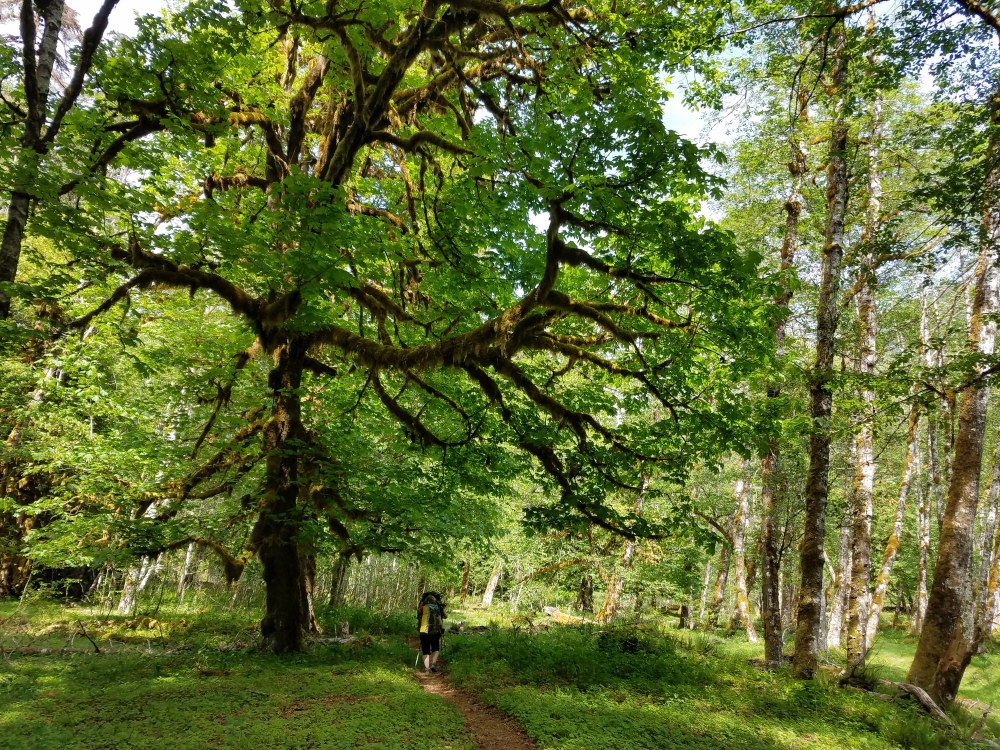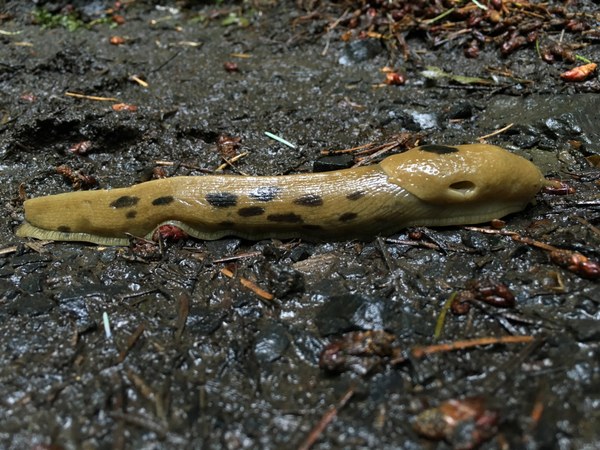
Last May, what started out as a straight forward backpacking trip turned into a harrowing ordeal for Mountaineer member Michael Kelly. With humor and grace, she recounts the good, the bad, and the downright ridiculousness of having to travel five miles without the use of her right leg.
We encourage our readers to keep Michael's story in mind on their adventures. When managing risks in the backcountry, we must all factor in the difficulty of a rescue operation miles from the nearest road. Accidents happen, even on relatively “easy” trails. Make sure you have a plan before you go!
I knew it would be hard to make it out.
Two days prior I had taken a nasty fall as my trail companions Nanci, Laurie, and I were backpacking into the Enchanted Valley, a lovely meadow northeast of Lake Quinault. As we approached our camping spot at the 12-mile mark, the “horses to barn” mentality set in and we started cruising down a hill with large rocks imbedded in the dirt. I was suddenly down, hitting the ground hard on my right hip.
I unbuckled my pack, rolled over, and laid on the trail, fighting waves of nausea. There were no obvious injuries, though I felt spacey and in mild shock. There was only a little over a mile left to camp, so I pushed on.
I was able to make it to camp, where I spent Saturday cycling through napping, walking, and stretching, while Laurie and Nanci went off to explore the trail toward O’Neil Pass. I checked in with the rangers in the area, Richard and Brendan, to let them know about my injury and our plans to hike out. By evening I could almost do a few yoga poses and get my own socks on – the 13-mile hike out looked like a go.
We broke camp, tucked away our dew-soaked tents, and were on the trail shortly after 6am. I was in the “lead,” traveling slowly with short breaks every 45 minutes. At the 7-mile mark, I was starting to feel grinding in my hip. My pace began to slow. Then, my right foot slipped and I went flying. I landed hard on the ground alongside the trail. “This is not good!” I screamed. Looking down, I realized I had been felled by a large banana slug. “How could there be so much slime in one place?” I thought to myself. “I know they grow giant slugs in the Olympics, but really?”
It didn’t take long to realize I could not put any weight on my right leg: the last five miles to the car now looked less possible. There was no cell service and I was stuck, unable to even crawl. Laurie took off down the trail to reach her car and drive the six miles to the nearest ranger station. Fortunately she ran into the ranger from our camp spot, Richard, near the trailhead. She alerted him to my injury and followed him to the North Forks Ranger Station to get the rescue started. Meanwhile, Nanci and I knew we had a long wait ahead of us. Laurie had left us with her emergency first aid kit, and I had one, two, and finally three doses of oxycodone to calm the spasming and cramping. I was eventually able to reposition myself onto level ground with a sleeping mat to lie on.
1pm - A doctor passed by as he and his companion were working their way up the valley for the night. Asking if he could examine me, he did not find any signs of bruising or internal bleeding. They insisted on staying with us until they could pass me off to a ranger or an EMT. By 1:30 a group passed by with a satellite phone, allowing us to get an emergency call out.
By this point, we had multiple calls out and knew help was coming. Two hours later, Ranger Brendan arrived, relieving the doctor as we continued to wait for emergency services. The oxycodone was wearing off, but fortunately the pain and cramping had subsided. Brendan did not recommend taking any more medication as I needed to be alert with strong vital signs when the EMTs arrived. The warm day faded into the shadows and, with the sun going down, the temperature started to drop. We bundled up and awaited the arrival of the rescue team.
9pm - Our EMT Katie and her husband Steve arrived. They knew the Olympic Mountain Rescue team was assembling at the trailhead and were on their way via headlamp. My trail companion Laurie was also on the way back with food. It was wonderful to see her breeze in; we knew she’d be back in spite of the extra ten miles.
11pm - We heard via radio communication that the team was getting closer, and it was time to “package” me into a transportation device. Katie and Steve carefully transferred me into the middle of what looked like a large bean bag, using my backpack as a back rest and cinching the straps tightly. In a flash, the team arrived and announced that we were going out that night. We had five miles to travel, and at a good pace they expected to move about one mile per hour. They assembled the litter and attached one large wheel in the center of it. I was lifted on top and cinched in by a second set of straps. It took five people to keep it balanced: two on each side and one at my head. It felt like a large unicycle.
11:30pm - I was finally moving along the trail after 12 hours of patiently waiting, conserving energy, and trying to keep my mind and body calm. The lead scout and the five people circled around me were in constant communication about upcoming hazards. Their dialogue provided an ongoing and insightful soundtrack to my trip. We went up, down, and over rocks, and dropped into a few holes. The trail became narrow and sometimes we’d lose one of the rescuers when they were brushed off or fell into me. Hours went on and the team would seamlessly rotate to alternate their carrying arm or request a replacement. I could see the sweat dripping off them and knew what hard work it was. Our EMT Katie would occasionally pop into view to ask if I was okay.
The biggest challenge for the team was crossing Fire Creek, the bridge being too narrow for me and my entourage to pass over. The leader had scouted out the creek in advance. He had found an area that looked like a safe crossing, even though the water was moving fast over the rocks and at places was a foot deep. Before I knew it, the team was pulling me across the stream. The next challenge was a long uphill climb; the rescuers commented that last time they faced a hill like that, they had a mule to help. Two of the rescuers attached ropes to the front of my rig and slowly pulled me up the trail.
3:30am - Around this time we arrived at the trailhead, a full hour earlier than expected. Our EMT offered to call an ambulance to transport us to the closest hospital, but I preferred to get into Laurie’s car and endure the 4-hour drive to a hospital back home. After hours of being “packaged,” I was so stiff I could only move my arms. I was carefully transferred into the car, with two oxycodone to set me up for a comfortable ride back to Seattle.
7:30am - We arrived at Valley Medical Center, and by 3pm I was being wheeled back into my room with a total hip replacement, the “Ferrari” model with titanium and ceramic. My surgeon told me I’d feel the effects of the injury for six weeks, but I could get back to hiking and even backpacking with full pack weight quickly. The summer was not lost! That evening was filled with visits from family and featured a wonderful dinner from the hospital kitchen, my last real meal since breakfast 18 hours before.
Reflecting on the rescue and all that it involved, my first thought is how blessed I was to be surrounded by loving family and friends, and embraced by the kindness of strangers. I’m deeply grateful to the role each of them played in my rescue. I know I’ll be back on the trail soon. Thank goodness for modern medicine!
Lessons Learned
- Consider carrying a satellite communication device and know how to use it – one can’t count on cell service
- Share your trip plan with a friend before you leave
- Make sure your fellow trip members have your emergency contact’s information
- Listen to your body, stay calm, and be clear with your needs during an incident
- Be grateful for the kindness of strangers, friends, and family
- Watch out for slugs
 Photo by Douglas Indrik.
Photo by Douglas Indrik.
Michael joined The Mountaineers in 2003 and has taken courses in Snowshoeing/Winter camping, Wilderness First Aid, Navigation, Sailing, Intro to the Natural World, and Conditioning Hiking. She credits meeting like-minded people in The Mountaineers changing her life. Her recovery is going well, and she recently enjoyed her first backpacking trip since the accident.
Olympic Mountain Rescue - Thank you! Michael would like to thank the Olympic Mountain Rescue team for their successful rescue efforts. Olympic Mountain Rescue is a volunteer organization dedicated to saving lives through rescue and safety education. Their response and professionalism exemplified the dedication and expertise of their organization.
This article originally appeared in our Fall 2018 issue of Mountaineer Magazine. To view the original article in magazine form and read more stories from our publication, click here.
 Michael Kelly
Michael Kelly